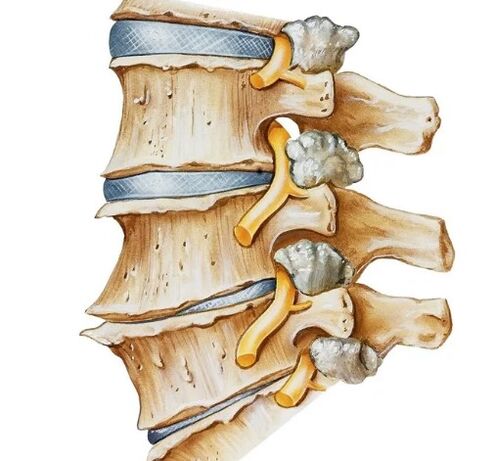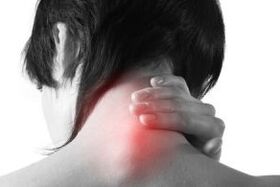HorseOsteocondrosis of cervical spine symptoms and treatmentThey will be different depending on the deformation type in the cervical vertebrae, which is achieved by long physical, inflammation or mental influence.

The disease is often chronically, squeezing the blood vessels from nervous roots and spine, manifests itself by many clinical symptoms. Their compression, intervertebral discs abrasion or deformity (reduce their talls, loss of elasticity, deformity of fiberglass or tearing). Cervical osteocondrosis is a common disease that occurs in any age after 20 years.
The cause of pathology is in the spine in destructive changes. First of all, changes in intervertebral disks include: their elasticity, decreased strength and height, fiber ring deformation, protrusions (initial stage of intervertebral rhogles) and the initial stage of intervert). All these changes cause bone growths and displacements in the spine (osteophycomes), and then cause the mobility of cervical vertebrae. A flexible protection for the spinal cord is "case", the loss of destructive changes in intervertebral disks and the elasticity of tangy vertebrae is harmful to the nervous and vascular structure of the spine. These are comprehensible and displacement of the service turnover and only the cervical and shoulder zone and the internal organs, which violated the innervation of the sub-extremities.
The patient, under the influence of the age, more changes in intervertitant discs, spine, injuries, injuries, formation, stressful situations, and the curry of the spine, etc.

Due to the anatomical structure, cervical spinal patholism is more prone to pathology, because the vertebrae is most dense with mobile and one with each other. In addition, there is weak muscle protection in cervical vertebrae. Most, degenerative changes are most mobile 5. 6, 7 cervical vertebra develops in intervertebral disks.
Osteocondrosis of cervical spine symptoms and treatmentComprehensive and compounded with the type and severity of the degeneration of intervertebral disks should be taken into account. The symptoms of cervical osteocondrosis are different and contradictory, because they depend on the deformation of intervertebral disks, the deformation of nervous roots and blood vessels, as well as the location of the muscles and organs, or placing the venues.
Therefore the complaints of patients are a neurologist, but other professionals, other professionals, a cardiologist, therapist, autolaryngologist, an optometrist, an optometrist, a rheumatologist, etc. At the same time, a neuropathologist can diagnose cervical osteocondrosis based on the results of the brain and the brain of the brain, the brain of the brain.
Experienced specialists, the combination of the symptoms of cervical osteochondrosis know thirty different options. It will not be possible to describe all the signs of the manifestations of this general disease, so let's continuethree complexesBasic symptoms that characterize a certain impaired function of the central nervous system.
The first complex of the main symptoms applies to impaired functions of the peripheral part of the nervous system. This department is represented by other elements leaving nerves and brain and spinal cord and divided into somatic and autonomous systems.
In short, the first complexes of cervical osteocondrosis are presented in the form of different localization. It is only painful in signs, often pains are combined with other disabilities body functions. But basically - these are constantly or periodically in the neck, the appearance of the patient's hypothermia, a long-term stress or disturbing pose, the sharp return of the effect.
The pain is like painful, firing or shock. Their localization depends on the tension of certain muscles related to the special roots of the nerves compressed in Vertabra. Therefore, pain, neck, nope, shoulder, one or in your hand, chest, heart, the territory of the liver. In addition, while moving, the cervical region has a crisis or whirlpool complaints in the vertebrae, as well as the hardness of the head rotation.
At the sharp start of the disease, the pain and spasm of neck muscles and spases of the patient to make a pose of a patient. If the cervical vegetative structures are squeezed and the blood supply is broken, the burning pain may appear between the shoulder blades. Such pains usually increase with physical and emotional stress.
Often swelling, affordable and cooling, their numbness, disgusting heartbeat, pain in the heart of students, the narrowing or sport of students, or spat. Patients complained about pain, the inability to be raised and the hardness of the shoulder combination.
The second symptoms of cervical osteocondrosis occur according to the function of violated the spinal cord and manifests itself with engine riots.
Due to the disorder of the spinal cord functions, due to compression due to compression, a Paper core occurs from the disk or injury and growth and growth (osteofit). Depending on the mechanism of exposure to the spinal cord, the following complex of motor disorders are recorded: weakness of oxengital and cervical muscles, weakness of the legs and feet, the tone of foot muscles and tone and tone and the tone of the tone and the tone of the tone and weight loss; loss of temperature and pain sensitivity; Strong fatigue of the legs, coordination was broken.
The third symptom sets the pathology of cranial nerves that occur in the brain's veins and the deformations in the cervical vertebrae. The symptoms of the vascular pathology are reflected.
Characteristic symptoms of vascular disorder:
- neurotic conditions (irritation, longing, anxiety, fatigue, sleep disorders);
- fainting; headache and dizziness; nausea and vomiting;
- loss of noise and sound hearing in their ears;
- visual disorders (darkening, fog, leash points, visual impairment);
- Glorious mining syndrome (sore throat, an external object, dryness, absorbing difficulty).
The symptoms of cervical osteocondrosis are unequivocally and should be considered in the complex and the pathological processes in the waist.
Only one qualified specialist can deal with clinical manifestations of this disease, diagnose and determine the proper treatment of the causes of revealed disorders.
The osteocondrosis of cervical spine and treatment depends on the nature of the patient, the severity of the disease and the nature of the cervical vertebra.
Hospitalization and drug treatment may be required in the acute period. Usually, the analgesic, which eliminates muscle spasm, use the novocaine muscle blockade, muscle streams; Chondroproproprotants for the nutrition of cartilage fabric; Sedative drugs that soothe the nervous system, increases vitamins B vitamins and neuromuscular conductivity. The treatment of osteocondrosis of cervical spine should always be long and complicated.
If there are no acute symptoms, physiotherapy methods (electrophorez, ultrasound, etc. ) are widely used, therapeutic physical education, massage, as well as active procedures, acupuncture.

Many conservative treatment methods of osteocondrosis are known to suspend the progress of the disease. However, in each patient, the stage of disease requires a course of treatment, taking into account the features of the body, sex and age. The purpose of the treatment of cervical osteocondrosis:
- Elimination of pain and edema in inflammation.
- Relaxation of tense muscles of the neck.
- Release of compressed nerve roots.
- Increased blood circulation.
- Activation of metabolism.
- Improving the power of intervertebral discs.
Purpose complex treatment may prevent the occurrence of protrus and intervertebral torns.
Osteocondrosing and treatment for symptoms and treatment have not begun and heavy complications of the disease should begin treatment in a timely manner.

























